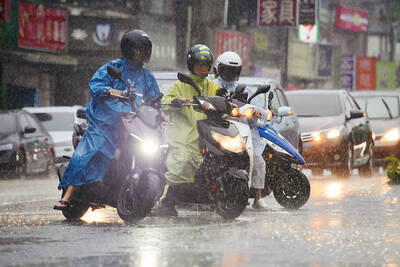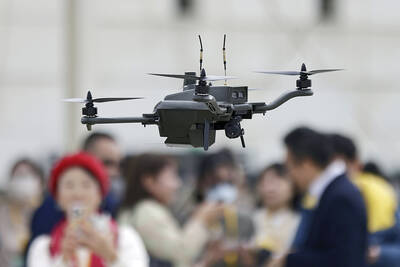The Central Epidemic Command Center (CECC) yesterday reported the first locally acquired cases of new Omicron subvariants XBB and BF.7.
Centers for Disease Control (CDC) Deputy Director-General Philip Lo (羅一鈞), deputy head of the CECC’s medical response division, said that among the 139 sequenced samples of local cases last week, 134 cases (96 percent) were infected with the Omicron BA.5 subvariant, three had the BA.2 subvariant, and one each had the BF.7 and XBB subvariants.
The BF.7 case is a woman in her 60s living in the south who has received three doses of a COVID-19 vaccine, Lo said, adding that she tested positive when she sought treatment on Oct. 19.
The XBB case is a man in his 40s living in northern Taiwan who has received three doses of a COVID-19 vaccine.
He was first diagnosed with COVID-19 on Aug. 30, developed a fever, coughing and runny nose on Oct. 15, and tested positive on Oct. 17, Lo said.
Neither of them had traveled abroad or had any close contact with people who had arrived in Taiwan recently, making them the first locally acquired cases of the XBB and BF.7 subvariants, he said.
Of the 26 sequenced samples of imported cases last week, 54 percent (14 cases) were infected with BA.5, 19 percent (five cases) each had the XBB and BA.2.75 subvariants, and one case had the BQ.1/BQ.1.1 and BA.2 subvariants, he said.
The imported XBB cases arrived from Singapore, Indonesia, India and Thailand, while the BQ.1/BQ.1.1 case arrived from Canada, Lo said, adding that the XBB cases detected so far were all from Southeast Asian countries, while the BQ.1/BQ.1.1 cases arrived from Europe, Canada and the US.
The XBB subvariant is a recombinant of BA.2.10.1 and BA.2.75 subvariants, and WHO data show that it has been reported in 35 countries, with a global prevalence of 1.3 percent, Lo said, adding that the severity of XBB cases is not higher than previous dominant Omicron subvariants.
The XBB cases also showed a higher reinfection rate, but mostly in people who have previously been infected with other COVID-19 variants, such as Alpha or Delta, and there is currently no evidence suggesting that it has higher immune escape from previous infection with Omicron subvariants, Lo said.
The XBB subvariant has become the dominant strain in Singapore, with cases peaking late last month, after it was first detected in July, Lo said, adding that the XBB wave was shorter and had fewer cases than the two previous waves in March and July.
The CECC also reported 22,593 new local cases and 59 deaths.
The local caseload yesterday was 14.2 percent lower than that on Monday last week, said CDC Deputy Director-General Chuang Jen-hsiang (莊人祥), the CECC’s spokesman.
Deputy Minister of Health and Welfare Victor Wang (王必勝), who heads the center, said weekly new local cases have steadily dropped by about 10 percent for three consecutive weeks, and that simulations suggest that the average daily caseload might drop to about 10,000 to 20,000 cases per day by the end of this month.
Chuang said a shipment of 624,000 doses of the Pfizer-BioNTech vaccine for children aged six months to four years arrived yesterday.
The latest batch is due to expire on April 30 next year, he said, adding that was the last of a total order of 1,900,800 doses for this year.
He said the center also discovered that some people are selling their positive at-home COVID-19 rapid test results online, which is against the law, and that it has reported the cases to the prosecutor’s office for investigation.

The combined effect of the monsoon, the outer rim of Typhoon Fengshen and a low-pressure system is expected to bring significant rainfall this week to various parts of the nation, the Central Weather Administration (CWA) said. The heaviest rain is expected to occur today and tomorrow, with torrential rain expected in Keelung’s north coast, Yilan and the mountainous regions of Taipei and New Taipei City, the CWA said. Rivers could rise rapidly, and residents should stay away from riverbanks and avoid going to the mountains or engaging in water activities, it said. Scattered showers are expected today in central and

COOPERATION: Taiwan is aligning closely with US strategic objectives on various matters, including China’s rare earths restrictions, the Ministry of Foreign Affairs said Taiwan could deal with China’s tightened export controls on rare earth metals by turning to “urban mining,” a researcher said yesterday. Rare earth metals, which are used in semiconductors and other electronic components, could be recovered from industrial or electronic waste to reduce reliance on imports, National Cheng Kung University Department of Resources Engineering professor Lee Cheng-han (李政翰) said. Despite their name, rare earth elements are not actually rare — their abundance in the Earth’s crust is relatively high, but they are dispersed, making extraction and refining energy-intensive and environmentally damaging, he said, adding that many countries have opted to

FORCED LABOR: A US court listed three Taiwanese and nine firms based in Taiwan in its indictment, with eight of the companies registered at the same address Nine companies registered in Taiwan, as well as three Taiwanese, on Tuesday were named by the US Department of the Treasury’s Office of Foreign Assets Control (OFAC) as Specially Designated Nationals (SDNs) as a result of a US federal court indictment. The indictment unsealed at the federal court in Brooklyn, New York, said that Chen Zhi (陳志), a dual Cambodian-British national, is being indicted for fraud conspiracy, money laundering and overseeing Prince Holding Group’s forced-labor scam camps in Cambodia. At its peak, the company allegedly made US$30 million per day, court documents showed. The US government has seized Chen’s noncustodial wallet, which contains

SUPPLY CHAIN: Taiwan’s advantages in the drone industry include rapid production capacity that is independent of Chinese-made parts, the economic ministry said The Executive Yuan yesterday approved plans to invest NT$44.2 billion (US$1.44 billion) into domestic production of uncrewed aerial vehicles over the next six years, bringing Taiwan’s output value to more than NT$40 billion by 2030 and making the nation Asia’s democratic hub for the drone supply chain. The proposed budget has NT$33.8 billion in new allocations and NT$10.43 billion in existing funds, the Ministry of Economic Affairs said. Under the new development program, the public sector would purchase nearly 100,000 drones, of which 50,898 would be for civil and government use, while 48,750 would be for national defense, it said. The Ministry of